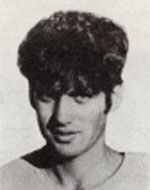Yungman, Ronnie
Roni, son of Mira and Dan, was born on April 30, 1953, in Haifa. He attended the “Zichron Yosef” elementary school in the mansion, and completed his high school studies in the general humanistic track at the Haifa Municipal High School. A tall, black-haired boy was Ronnie, with large blue eyes and a black hair on his high forehead. He did not excel in his studies, but due to his serious attitude toward his debts and his personal integrity, he successfully completed his high school studies. One of his teachers at the high school attests to him, who impressed him as a kind, serious and profound boy. Roni was a central figure in every event and social gathering. Already in elementary school he was active in the Scouts movement in his city. He later became a guide and a center of the movement. Ronny devoted his energies and faith to the youth movement. His activity in this framework was natural, as part of his personality and image. His friendly attitude towards others and his willingness to devote himself to achieving a broad goal that would serve the community – all found expression in class and especially in movement. Ronny was drafted into the IDF in mid-November 1971 and volunteered for the Nahal paramilitary brigade, during which he was a test period for his physical fitness – since he had previously been injured in a work accident – and his ability to work in a team. He met all the challenges he faced, and was sent to instruct the members of the “Amit” Scout troop in Haifa, and devoted himself diligently to maintaining his ties with the nucleus. Roni joined the artillery course and finished with a high score (92). When the “Yefe Nof” core was raised to the Golan Heights, in order to establish the Kfar Haruv outpost, Roni was among the activists and was meticulous in matters of order, discipline and work ethics. The waiting period at Kibbutz Afik allowed Roni to look closely at the settlement plan. He guided the nuclei of acceptance, took care of them and helped them, and also fought to bring “good young couples from kibbutzim.” In a practical approach, he demanded to give decisive answers to the young people’s absorption requests: “Since the absorption possibilities are limited, there is room to be reserved for those who are very interested in the kibbutz,” Roni said. He was energetic and decisive, and when the core of the Haruv was on the ground, Roni was the leader of the initiative, a symbol of consistency and stability. He never satisfied himself with seeing the present; He looked up into the future and said: “Now – land, tomorrow – people.” When the Yom Kippur War broke out, Roni was drafted into an artillery battalion that joined the braking system in the Golan Heights. His friends say that Ronny stood out in his usual optimism, and expressed complete confidence in the outcome of the difficult campaign. He worked as an officer and excelled in proficiency and skill in everything related to his weapons. While all the people were rushing to take shelter in the shadow of the battery attacked by the enemy planes, Roni hurried to the wounded, helped evacuate them and returned to the fighters. The shadow of a smile floated on his lips, and in his smile he sought to keep Muriel his fighting friends. He kept the sights of the horror to himself. He knew that presenting mental weakness would not work, and did his best to encourage his friends during the difficult times of battle. On the 17th of Tishrei 5734 (17.10.1973), the night of Simchat Torah, Roni was killed by enemy fire during the battle east of Khan Arnabeh, on the Golan Heights. He was laid to rest in the military cemetery in Haifa. Survived by father, mother and sister. After his fall, he was promoted to corporal. In a letter of condolence to the bereaved family, then-Defense Minister Moshe Dayan wrote: “Ron served in the paratroop brigade, and he was a devoted soldier and exemplary friend. Roni’s parents and friends in Kfar Haruv called the memorial park in the Lev of the young farmAfter Roni, they erected a monument there and surrounded it with a young tree grove; They also published a memorial booklet in his memory; Roni’s friends in the village of Haruv, tell of his way and his personality in a leaflet of Kfar Haruv; Educators ‘and students’ remarks about Roni as a high school student, published in the newsletter of the Municipal High School in Haifa.
